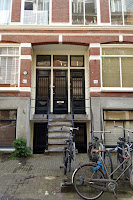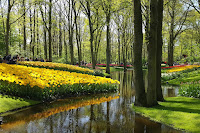One short train ride away from Amsterdam along the river Zaan is an area of land that used to be a hub of industry for the Netherlands - Zaanse Schans. The wide expanse of what is now mostly farmland and factories at one time had nearly a thousand windmills operating for different purposes. Now, a small area holds eight large old windmills. They were all relocated to what is now a tourist park that also holds demonstrations on dutch goods. I will admit that at first I sneered at what I was calling "Dutch Disneyland" with its fake houses, neatly trimmed gardens and decorative bridges. Touristy as it is, there are actually some extraordinary features at the park.
First, the train station is on the wrong side of the river. As you cross over the Zaan you can see four of the windmills. Two hundred years ago both sides of the river and along the lesser canals the banks would have been jam-packed with these technological wonders.
One of the buildings houses a small clock museum, which was interesting. Some of the oldest pendulum clocks in the world are here (17th century)
A clockmaker's tools
The weather was bitterly cold but we had a healthy breeze which meant the mills were turning spectacularly fast. Our park tickets only allowed for an inside look at one windmill (any additional ones would cost extra). The immediate choices before us were a sawmill, oilmill, and dyemill. I had never heard of a dyemill before so we went inside De Kat (The Cat)


The original Kat mill was built in 1646 but the current one was built in the early 1900s. Previous iterations have burned down or been partially demolished. The Cat is the only remaining working windmill in the world that is making paint. The milling stones are used to grind raw materials that contain pigment so that it can be combined with linseed oil or other delivery solvents to make paint. When we were there the apparatus was being used to grind chalk, which gets used for sports fields or made into artist pastel crayons. There were examples of the pigments that are made too. For instance, cinnabar (or natural vermilion) is ground up for its bright orange-red color). With the fans of the mill spinning outside, the giant wooden cogs and axles were moving so fast they made the whole building shake.







There was a decent museum about the area and its history. Interestingly, the green paint theme that matches the windmills to other park buildings and neighboring town businesses isn't a tacky gimmick to make the Zaan waterfront look uniform. It turns out that nobody really knows what the original building colors would have been in the 1600s. They've made their best guess by using artworks as a reference. Zaanse Schans was once considered to be very snobby about trying to preserve the history of Dutch culture. The people were ridiculed so much they began to purposefully hide all record keeping and even made superficial alterations to the town's look in order to seem more modern.

That doesn't mean the park isn't still touristy. There was a cheese hall selling products from their sponsoring creamery, a "baking museum", and a clog museum with gazillions of wooden shoes readily available for purchase! They did have a small section of authentic Delft porcelain in the gift shop but I passed on that until I could educate myself on such potentially pricey objects.
When we returned to Amsterdam I elected to check out the Red Light District during daylight hours so we would case the area before coming back at night. There seemed to be a higher concentration of Coffeeshops in the area. It was kind of like the end of a long night out when the bar lights are turned on at closing time and everything looks really ugly. I didn't expect the sex workers' windows to be occupied at three in the afternoon but I was quite wrong. The pink lights clashed with the grey daylight and the ladies' eyes wore expressions with thousand-yard stares.
This seems like such an inappropriate transition photo-wise, but after our quick tour we walked back to Dam Square (it's really close to the RLD). The wreaths we had seen being presented last night were still on display at the national monument.
We walked some more around town and came upon the "floating" flower market, a long collection of stalls with fresh flowers, bulbs, and seeds available for purchase. Because the area attracts so many tourists they all carry broad souvenir collections.
It had been a long day and neither of us really ate lunch so it was time to figure out dinner. I found a highly-recommended place that served Dutch food and we were not disappointed. I had a casserole that was like a sheperd's pie: Curried onions and ground beef mixed with a little cheese and cauliflower. This was topped with mashed potatoes and run under the broiler. Hans had some interesting mashed potatoes mixed with sauerkraut and sausage. Did I mention that I had salted herring?
Oh, yes.
Two. Raw. Fish.
Served with onions and pickles.
Honestly, I liked it. The salt wasn't too strong and the garnish helped to break up the bites of food. If you're okay with eating sashimi, the herring here isn't offensive. Hans was okay with one bite and after that he was grossed out.

Since some of the museums are open late on Fridays we elected to visit the Van Gogh one after dinner. There was a bit of excitement here because two paintings that had been stolen 14 years ago and recently returned were on display but only for a short time. After May 14th they will undergo restoration before being returned for permanent display. If you love Van Gogh, this is the museum to visit. The Museé d'Orsay has a pretty comprehensive collection but what I really liked about the one here in Amsterdam was that it told the story of Van Gogh's relationships with his contemporaries. I learned that he studied Japanese art for color use and composition. Also, Almond Blossoms is even more beautiful in person than either Hans or I could have imagined. We couldn't stop staring at it.
We basically stayed until the museum closed at 10 pm so we were pretty exhausted at the end of the night. I gave up on the idea of going back to the RLD tonight because I couldn't find my transportation pass and we took that as a sign that we should just go to bed.
The flower market
"Rush hour" at the Rijksmuseum
May 5th is the Netherlands' Independence Day.
There was also a tall crane giving rides to people (up, up, up, then down, down, down).
Tot ziens!












































































